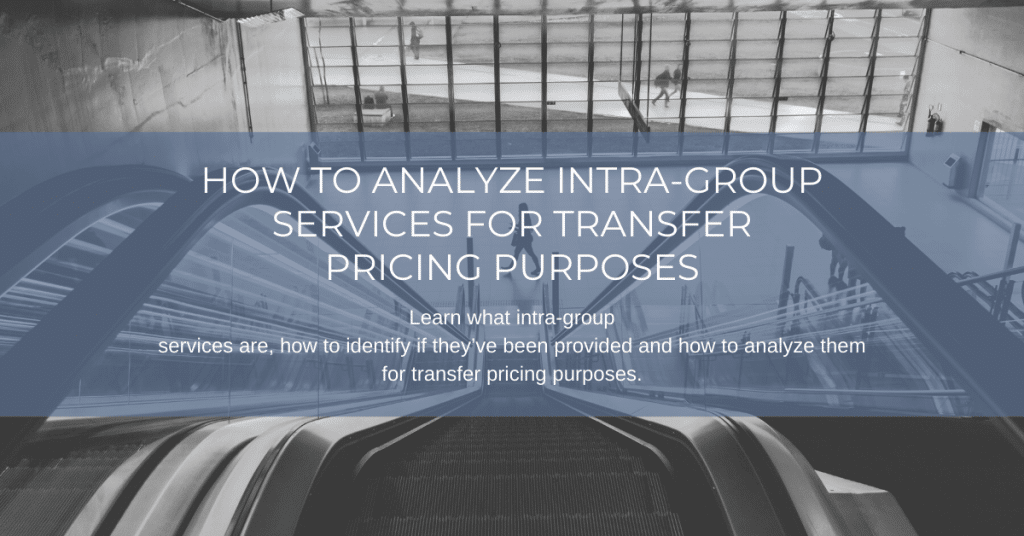How to analyze intra-group services for transfer pricing purposes
November 15, 2019

If a company within a multinational enterprise group (MNE group) provides an intra-group service to another company within that MNE group, that company must charge an arm’s length fee for the service. Just like with any intra-group transaction, the fee must be the same as what it would have been had the service been provided to an independent party.
On this page, you will find information about what intra-group services are, how to identify if such services have been provided, and how to analyze them for transfer pricing purposes.
If you need reliable comparables data on service fees, you can search the RoyaltyRange service fees database for real, recent third-party agreements covering over 30 service types.

The OECD’s guidance on intra-group services
The Organisation for Economic Co-operation and Development (OECD) provides guidance on transfer pricing for intra-group services in its Transfer Pricing Guidelines for Multinational Enterprises and Tax Administrations 2017 (the TP Guidelines). You can find the guidance in Chapter VII of the TP Guidelines, titled ‘Special Considerations for Intra-Group Services’.
The OECD’s definition of intra-group services
The OECD defines an ‘intra-group service’ as:
“An activity (e.g. administrative, technical, financial, commercial, etc.) for which an independent enterprise would have been willing to pay or perform for itself.”
What is an intra-group service?
The term ‘intra-group service’ relates to services that are provided by one company within an MNE group to another company within that same MNE group.
The test for identifying intra-group services is to determine whether an independent enterprise would have been willing to pay for the service or to perform it for itself. This is called the benefits test. We’ll explain this in more detail in the following paragraphs.

How do you know if an intra-group service has been provided?
You can only class an activity as an intra-group service if it provides the related company with “economic or commercial value to enhance or maintain its business position.” You can find out if this is the case by identifying whether an independent enterprise in comparable circumstances would have paid an unrelated party for the service or performed it in-house.
This is known as the ‘benefits test’.
If you find that an independent enterprise in comparable circumstances would have either paid an unrelated party for the service or performed it themselves in-house, then it could be classed as an intra-group service. If not, it is probably not classed as an intra-group service.
Sometimes it’s straightforward to work out if an intra-group service has been provided
If an MNE group member has performed activities to “meet an identified need” of other members of the MNE group, it is fairly simple to identify whether an intra-group service has been provided. In comparable circumstances, an independent enterprise would have met the identified need by performing the service in-house or hiring a third party to perform it.
If the situation is less clear-cut, you will need to do a more complex analysis
There are situations and circumstances that require more complex analysis to identify whether an intra-group service has been rendered. We outline some of them below.
- Shareholder activities
If a parent or holding company provides a service to one of the MNE group members in its capacity as shareholder, this wouldn’t count as an intra-group service. The MNE group member probably didn’t request the service and, as such, the parent company should bear the costs. This would be classed as a shareholder activity rather than an intra-group service.
There are exceptions to this, however. For example, if a parent company raises funds for a group member, which then uses them to acquire a new company, this would be an intra-group service because the service benefits the group member financially and commercially.
- Duplication
Activities are generally not classed as intra-group services if they simply duplicate a service that another MNE group company is already providing. The exceptions to this are if the duplication is only temporary or is intentional to reduce the risk of a wrong business decision.
- Incidental benefits
Sometimes, MNE group members can benefit incidentally from intra-group services provided to other group members. Such incidental benefits do not ordinarily count as those inadvertent group members receiving intra-group services as, in a situation between unrelated parties, the independent enterprise would not be willing to pay for the service.
- On-call services
Some services are provided on-demand. A parent company may offer managerial, technical, financial or legal services to members of an MNE group as and when they need them. With services that are provided on-call, a separate ‘standby’ fee is often charged for the short-notice availability of services, on top of the service fee for the service itself. For transfer pricing purposes, you need to determine whether the availability of on-call services can be classed as a separate service in itself, for which the taxpayer needs to determine an arm’s length charge. If you conclude that an independent enterprise in comparable circumstances would incur standby charges for the service, then you should class the availability of the service as an intra-group service in itself, and identify a suitable arm’s length charge.
How to determine the amount that has been charged for an intra-group service
Once you have identified that an intra-group service has been provided, you need to determine whether the service fee charged was in line with the arm’s length principle.
The first step in doing this is to identify whether the MNE groups charged the associated enterprises directly or indirectly for the provision of services between them.
- Direct-charge method
A direct-charge method means that associated enterprises have charged each other directly for specific services. MNE groups are encouraged to use direct charging arrangements in cases where similar services to those rendered to the associated enterprises are also rendered to independent enterprises in a comparable manner. When an MNE group uses this method, it is clear for transfer pricing purposes what service has been performed and how it was paid for. This makes it simple to determine whether the fee is at arm’s length.
- Indirect-charge method
MNE groups are not always able to apply direct charge arrangements, particularly if the value of the service cannot be directly apportioned to each associated enterprise. As such, they use indirect methods to charge for intra-group services. These methods are usually based on cost allocation and distribution. MNE groups should choose an allocation key that makes sense under the circumstances of the transaction and that is easy to verify. For example, when allocating costs between associated enterprises for the provision of IT services, a suitable allocation key could be the number of PCs per associated enterprise.
How to calculate arm’s length pricing for intra-group services
To calculate arm’s length transfer pricing for an intra-group service, you need to consider: the value of the service to the receiving company; the amount an independent enterprise would be willing to pay for it in comparable circumstances; and the service provider’s costs.
There are a number of transfer pricing methods you can use to calculate an arm’s length transfer price. The most commonly used are the comparable uncontrolled price (CUP) method or a cost-based method such as the cost plus method or cost-based transactional net margin method (cost-based TNMM). We look at some of them in more detail below.
- The CUP method
The CUP method compares the price and conditions of intra-group services with those of an uncontrolled transaction between unrelated parties. It is an appropriate method if:
- A comparable service has been provided between independent enterprises in the same market
- The associated enterprise in question has also provided the service to an independent enterprise in comparable circumstances
To find out more, read our blog on the CUP method.
- The cost plus method
The cost plus method adds a markup on the supplier’s costs for the service so that the supplier makes an appropriate profit that takes into account the functions they performed and the current conditions of the market. The combined price is the arm’s length price for the intra-group service.
The cost plus method is most appropriate if there is not a comparable transaction available (where the nature of activities, use of assets and assumption of risks are comparable to those undertaken by independent enterprises).
Low value-adding intra-group services
Some intra-group services are classed as low value-adding. For such services, it is more difficult to determine whether the benefits test is satisfied (i.e. that the services provided economic or commercial value to the receiving company, and an independent enterprise in comparable circumstances would be willing to pay for the service or perform it in-house).
The OECD provides an elective, simplified approach to applying and documenting arm’s length charges for low value-adding intra-group services. The approach involves a simplified benefits test, a process for determining the costs associated with low value-adding services, the ability to use general allocation keys and a standard profit mark-up of 5%.
So, what are low value-adding intra-group services?
In order to constitute a low value-adding intra-group service, a service must be:
- Supportive in nature
- Not part of the core business of the MNE group
- Do not require the use of unique and valuable intangibles and do not lead to the creation of unique and valuable intangibles
- Do not involve the assumption or control of substantial or significant risk by the service provider and do not give rise to the creation of significant risk for the service provider
Examples of services that would likely count as low value-adding intra-group services are:
- Accounting and auditing
- Processing and management of accounts receivable and accounts payable
- Human resources activities such as staffing and recruitment; training and employee development; remuneration services; developing and monitoring staff health procedures, safety and environmental standards
- Monitoring and compilation of data relating to health, safety, environmental and standards regulating the business
- IT services where they are not part of the principal activity of the group
- Internal and external communications and public relations support
- Legal services
- Activities with regard to tax obligations
- General services of an administrative or clerical nature
Examples of services that would generally not qualify for the simplified approach are:
- Services constituting the core business of the MNE group
- Research and development services
- Manufacturing and production services
- Purchasing activities relating to raw materials
- Sales, marketing and distribution activities
- Financial transactions
- Extraction, exploration and processing of natural resources
- Insurance and reinsurance
- Services of corporate senior management
You can find more in-depth advice about low value-adding intra-group services in Section D of the OECD’s Transfer Pricing Guidelines.
Find third-party service fees agreements today
Do you need third-party service fees data for your transfer pricing analysis of intra-group services? The quickest and easiest option is to use the RoyaltyRange service fees database. We provide you with access to real service fees agreements, covering more than 30 service types (e.g. distribution, management and procurement services), 60 fee types (including sales commission, management fees and agent fees) and 30 fee bases (sales, cost, EBITDA, asset value, etc.).
Request One Search
We will perform the search and deliver the initial results within hours, at no cost.




